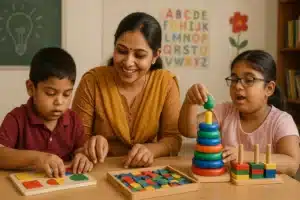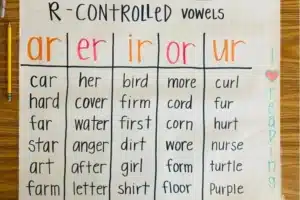
Source: pensxpress
Specific Learning Disabilities (SLD) are a set of learning disorders that arise due to neurological reasons in which the brain’s information processing power is affected leading to poor academic progress. As the child’s major brain development occurs during the early childhood period of 3 to 6 years the child’s learning capabilities foster during this age. However, due to Specific Learning Disabilities, the child’s abilities to learn English, Maths, and writing are hampered.
However, these challenges can be handled tactfully by trained special educators who have undergone the desired training under a Special education Program. Special Education Courses provide trainees with an in-depth understanding of various Specific Learning Disabilities and their symptoms and train aspirants in effective teaching methodologies that enable children with learning disabilities to overcome their academic challenges successfully.
Vidhyanidhi Education Society (Govt. Regd.), a pioneer Teacher Training Institute, has introduced a top-notch LD Course that has helped thousands of budding teachers embark on a flourishing professional path in Special Education. The course has been designed under the guidance of leading professionals who possess valuable experience of over two decades, equipping candidates to perform their job roles with total dedication and perfection.
For more details on the LD Course Call/Whatsapp at +919321024137 / +919869866277
To download the brochure of the LD Course, Click Here!

Source: classroom.synonym
Various Learning Disability Management Techniques
Learning Disability Management Techniques are the essential methodologies that have a major role to play in fostering the academic progress of the child. Learning Disability management techniques focus on the child’s strengths that help the child to learn in a manner that aligns well with his learning preferences providing practical and effective solutions.
Below are detailed techniques for managing common learning disabilities, along with examples:
For Dyslexia
Dyslexia is a learning disorder that hampers the child’s reading abilities as the brain does not process the information properly.
Intensive Teaching Techniques
A step-by-step, structured approach to teaching reading can significantly help. For instance, Phonics-based teaching activities are used that help to decode letters with their sounds correctly. This helps the child to recognize the words better leading to improved comprehension skills.
Classroom Modifications
Teachers can offer additional time for reading or writing tasks. For example, during a test, a student with dyslexia might be allowed to listen to an audio recording of the questions instead of reading them. This reduces anxiety and ensures the child can focus on their answers.
Use of Technology
Making use of interactive software like audiobooks can help children understand the topics with less effort and stress.
For Dysgraphia
Dysgraphia impacts writing skills, including handwriting, spelling, and composition.
Special Tools
Providing alternatives to writing can alleviate stress. For instance, a child might use an oral recorder to narrate an essay or work with a classroom buddy who takes notes for them during lessons.
Reducing the Need for Writing
Teachers can provide pre-printed notes and study materials. For instance, instead of asking a student to copy notes from the board, they can receive an outline of the lesson in advance, allowing them to focus on understanding rather than writing.
For Dyscalculia
Dyscalculia affects mathematical skills, including number recognition, calculation, and problem-solving.
Visual Techniques
Visual aids like charts, diagrams, and color coding can simplify complex concepts. For example, a teacher might use colored blocks to explain fractions, with each color representing a part of the whole.
Memory Aids
Mnemonics, rhymes, or songs can help students remember math facts. For instance, a student might learn multiplication tables using a song or a rhyme like “Zero the Hero stays our friend; he makes multiplying easy in the end.”
Computer Tools
Software programs that offer interactive math games or drills can reinforce concepts. For example, an app that uses gamified learning to teach addition and subtraction can help a child practice math in an engaging and stress-free way.
Learning Disability Management Techniques when implemented tactfully help educators to gain the desired learning outcomes helping children to attain their learning objectives.
These techniques lay the ideal groundwork for creating a conducive classroom environment that can harbour the thoughts of celebrating diversity and respecting everyone’s uniqueness empowering all children to attain academic success and be respected by the community at large.

Source: bubblewrapfun
What is the Learning Disability Assessment Process?
Individuals who are suspected to possess any learning disability must undergo quintessential assessment procedures that help to ascertain whether the person has a particular disability. The Learning Disability Assessment Process is a step-by-step methodical approach where information is gathered about the individuals.
This information is then analyzed under the guidance of trained professionals and a detailed review is produced enlisting the strengths and weaknesses of the individual to conclude whether they possess any Learning Disability or not. Is a systematic method for recognizing Specific Learning Disabilities (SLD). This process is important for understanding the root cause of difficulties in work, school, or daily life and can help individuals access the accommodations and approaches they need to succeed.
Below are the key stages involved:
Screening
- Screening is like a first interview of the individual where questions are asked to gather significant information enlisting the basic aspects of the individual’s challenges.
- Informal interviews to discuss areas of difficulty and personal history.
- Brief tests to assess basic skills like reading, writing, or math.
- A review of medical, school, or work histories to identify patterns of challenges.
- At times a teacher might notice that a child often writes mirror images of letters which can be a cause of concern that needs further evaluation and assessment.
Evaluation
- On arriving at the diagnosis that a learning disability has been detected certain formalities have to be performed to get a formal evaluation and documentation that needs methodical testing in the below listed areas.
- Performances: Reviews are conducted to calculate scores in reading, writing, and math.
- Reasoning: IQ tests are conducted to measure cognitive skills.
- Processing Skills: Tests to evaluate how the individual processes information, including memory and attention.
- For instance, a formal evaluation might reveal that a student has strong verbal skills but struggles with processing written text, pointing to dyslexia.
Diagnosis
- The diagnosis stage involves interpreting the results of the evaluation. A professional, such as a psychologist or learning specialist, will provide a clear statement specifying:
- Whether a Learning disability exists or not
- The exact diagnosis of the Learning disability and the type
- Mentioning the type of learning disability helps the caregivers and family understand the struggles and understand their experiences.
- Why Undergo a Learning Disability Assessment?
- The Learning Disability Assessment Process is valued for someone facing persistent challenges in school, work, or daily life.
Adults may seek assessment for reasons such as:
- Struggles to achieve career or educational goals due to learning difficulties.
- Issues in daily tasks like managing finances or decision-making.
A desire to understand the underlying cause of lifelong challenges with learning or memory.
By completing this process, individuals can access the documentation needed to request accommodations and develop effective strategies for success based on their unique strengths. For those dealing with Specific Learning Disabilities, this process can be the first step toward overcoming obstacles and achieving personal goals.
Boost your expertise with Vidhyanidhi’s LD Course! Enroll now and transform lives!
For more details on the LD Course Call/Whatsapp at +919321024137 / +919869866277
To download the brochure of the LD Course, Click Here!
FAQs
What are the Criteria for LD?
The Criteria for Learning Disabilities include poor academic progress despite normal intelligence and adequate teaching in areas of reading, writing, math, or language skills.
Is Learning Disability a Mental Illness?
No, Learning Disabilities are not mental disorders, they are just conditions that arise due to the brain’s difficulty in processing information affecting the individual’s learning skills.
Can you still be Smart with a Learning Disability?
Yes, many individuals with Learning Disabilities are highly intelligent and shine in various fields by improving their strengths and using effective approaches for success.



